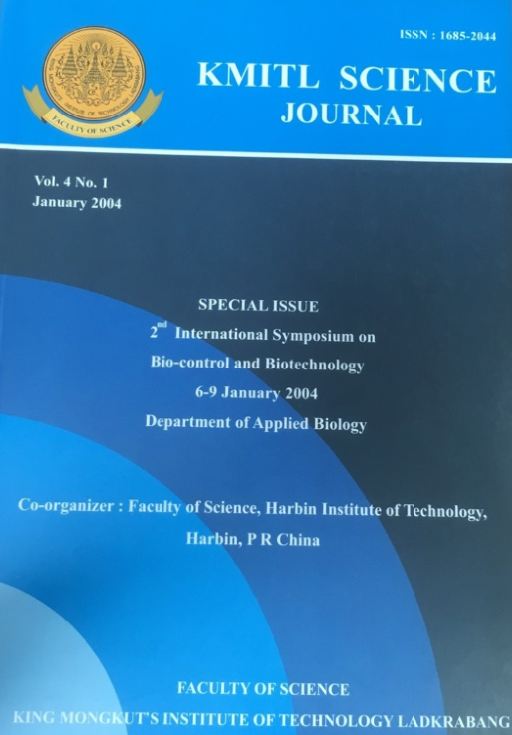Screening of Trichoderma Species for Biological Control Activity on Aspergillus flavus
Main Article Content
Abstract
Sixteen species of Trichoderma isolated from soil were screened according to the dual culture essays, antibiosis inhibiting test, and aflatoxin inhibition test on peanuts. TISTR3167 and C1-1 were selected for their better inhibition of aflatoxins and growth of Aspergillus flavus.
Keywords: Trichoderma, Aspergillus flavus, aflatoxin
Corresponding author: E-mail: cast@kmitl.ac.th
Article Details
Copyright Transfer Statement
The copyright of this article is transferred to Current Applied Science and Technology journal with effect if and when the article is accepted for publication. The copyright transfer covers the exclusive right to reproduce and distribute the article, including reprints, translations, photographic reproductions, electronic form (offline, online) or any other reproductions of similar nature.
The author warrants that this contribution is original and that he/she has full power to make this grant. The author signs for and accepts responsibility for releasing this material on behalf of any and all co-authors.
Here is the link for download: Copyright transfer form.pdf
References
[2] S.W.Peterson, Y.Ito,B.W.Hornand T. Goto, Aspergillus bombycis, a new aflatoxigenic species and genetic variation in its sibling species, A. nomius, Mycologia, 93, 2001, 689-703.
[3] C.P.Kurtzman, B.W. Horn and C.W. Heseltine, Aspergillus nomius, a new aflatoxin producing species related to Aspergillus flavus and Aspergillus tamarii, Antonie Leeuwenhoek, 53, 1987, 147-158.
[4] G.C. Ainsworth and P.K.C. Austwick. Fungal diseases of animals, 2nd ed. (Commonwealth Agricultural Bureau, UK : Slough, 1973).
[5] J.V. Rodricks and H.R.Roberts. Mycotoxin regulation in the United Stated. In Mycotoxins in human and animals health. (J. V. Rodrick, C. W. H.esseltien. and M. A. Mehlman, Park Forest South, IL: Pathotox Publishers Inc., 1977).
[6] Hassan Gourama and Lloye B. Bullerman. Inhibition of growth and aflatoxin production of Aspergillus flavus by Lactobacillus species. J. Food Protect. 58, 1995, 1249-1256.
[7] C.F. Jelinek, A.E. Pohland, and G.E. Wood. Worldwide occurrence of mycotoxins in foods and feeds-an-update. J.Assoc.Off.Anal.Chem.72, 1989, 223-230.
[8] D.V.R. Reddy, K. Thirumala-devi. Stimulation of aflatoxin levels in selected foods and feeds in India. (Proceedings of the International Workshop: France, Montpellier, 2000).
[9] P.J. Cotty. Effect of harvest date on aflatoxin contamination of cottonseed. Plant Dis. 75, 1991, 312-314.
[10] D. Thanaboripat. Importance of aflatoxins. KMITL Sci. J. 2, 2002, 38-45.
[11] P.J.Cotty and L. S. Lee, L.S. Aflatoxin contamination of cottonseed: Comparison of pink bollworm damaged and undamaged bolls. Trops. Sci. 29, 1989, 273-277.
[12] G. C. Papavizas. Trichoderma and Glicladium: Biology, ecology and potential for biocontrol. Ann. Rev. Phytopathol.,23, 1985, 23-54.
[13] G. D. Inglis and L. M. Kawchuk. Comparative degradation of oomycete, ascomycete, and basidiomycete cell walls by mycoparasitic and biocontrol fungi. Can. J. Microbiol. 48, 2002, 60-70.
[14] B.Gokul, J.-H. Lee, and K.-B. Song. Characterzation and application of chitinases from Trichoderma.harianum- A Review. Bioprocess Eng. 23, 2000, 691-694.
[15] M. H. El-Katatny, M. Gudelj K.-H. Robra. Characterization of a Chitinase and an Endo- β -1,3-Glucanasefrom Trichoderma harzianumRifai T24 Involved in Control of the Phytopathogen Sclerotium rolfsii. Appl Microbiol Biotechnol. 56, 2001, 137-143.
[16] N. J. Fokkema. The role of saprophytic fungi in antagonism against Drechslera sorokiniana (Helminthosporium sativum) on agar plates and on rye leaves with pollen. Physiol. Plant Pathol..3, 1973, 195-205.
[17] L. M. Seitz and H. E. Mohr, A new method for quantitation of aflatoxin in corn, Cereal Chem, 54, 1977, 179-183.
[18] N. Benhamou and I. Chet. Hyphal interaction between Trichoderma.harianum and Rhizoctonia solani : ultrastructure and gold chemistry of the mycoparasitic process. Phytopathol. 83, 1993, 1062-1017.
[19] C. Calistru, M. McLean and P.Berjak. In vitro studies of the potential for biological control of Aspergillus flavus and Fusarium moniliforme by Trichoderma species. 1. Macroscopical and microscopical observations of fungal interactions, Mycopathol. 139, 1997, 115-121.
[20] K. A. Wheeler and A.D. Hocking. Interaction among xerophilic fungi associated with dried salted fish. J. Appl. Bacteriol. 74, 1993, 164-169.
[21] N. H. Aziz and A. A. M. Shahin. Influence of other fungi on aflatoxin production by Aspergillus flavus in maize kernels. J. Food Safety, 17, 1997, 113-123.


